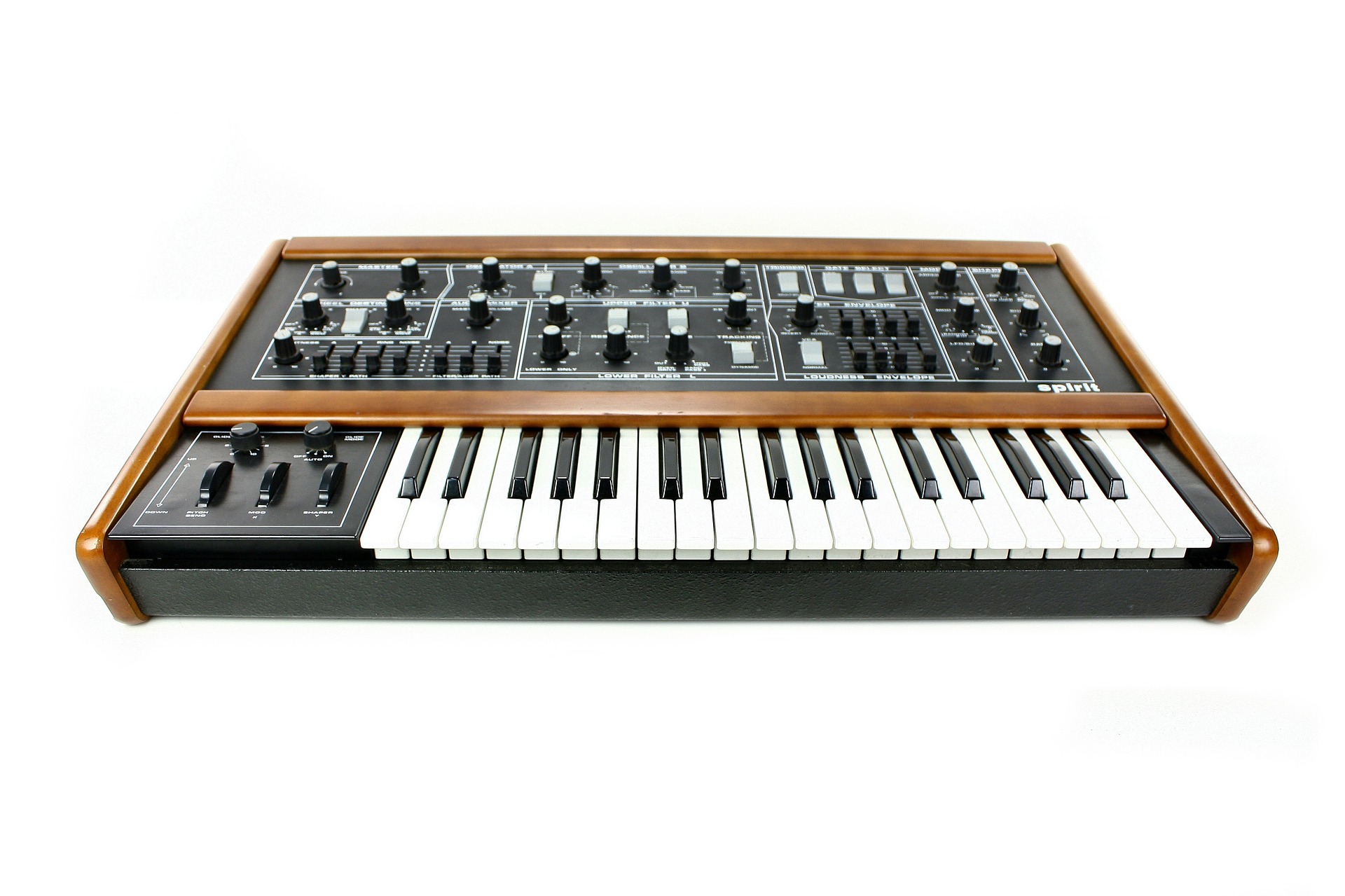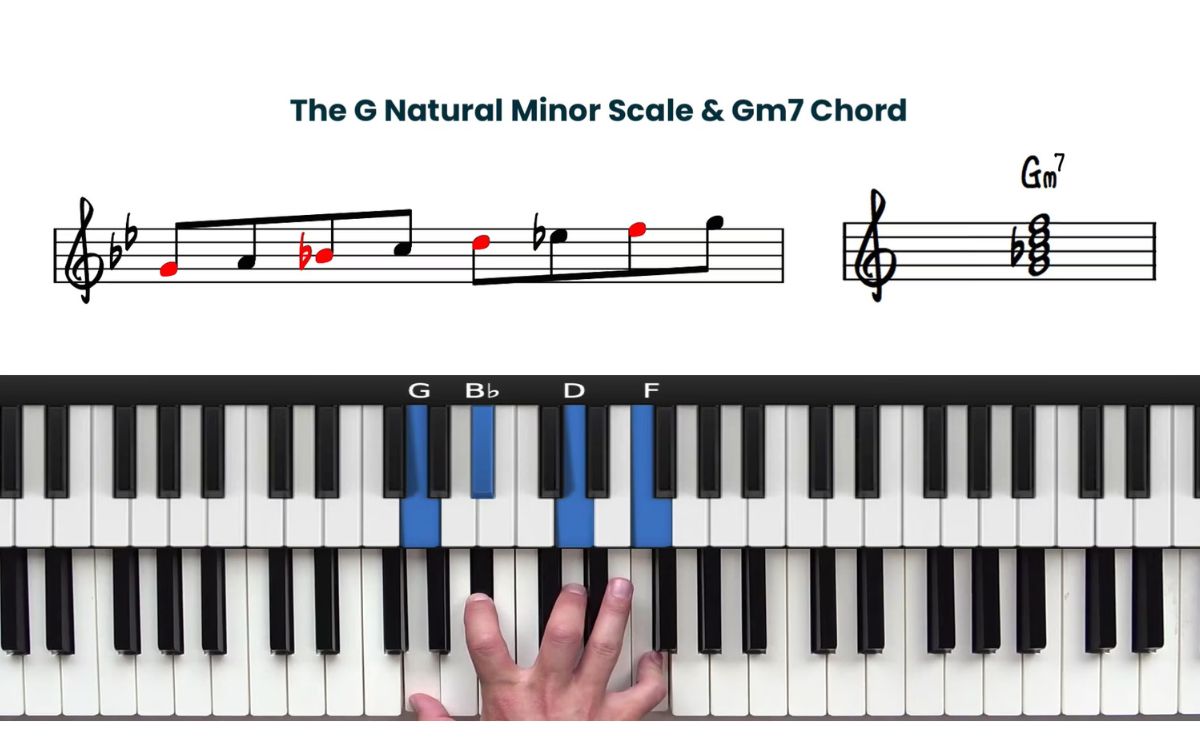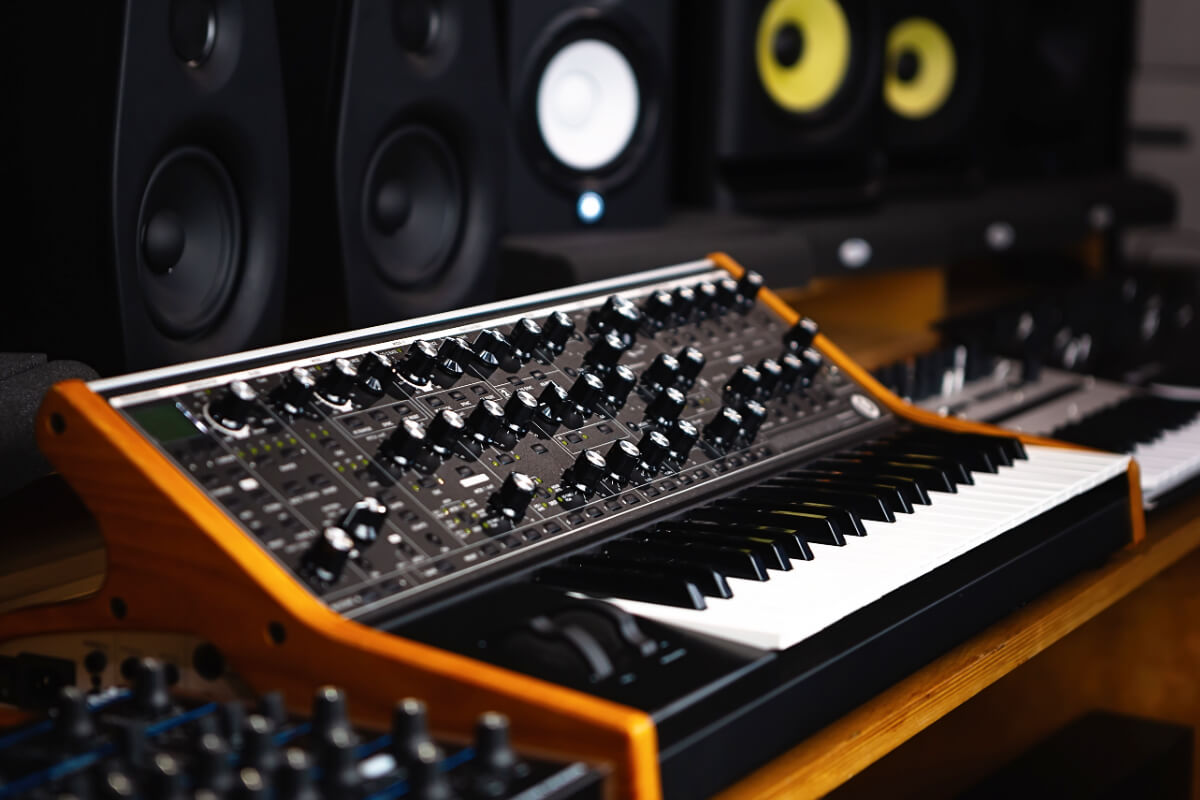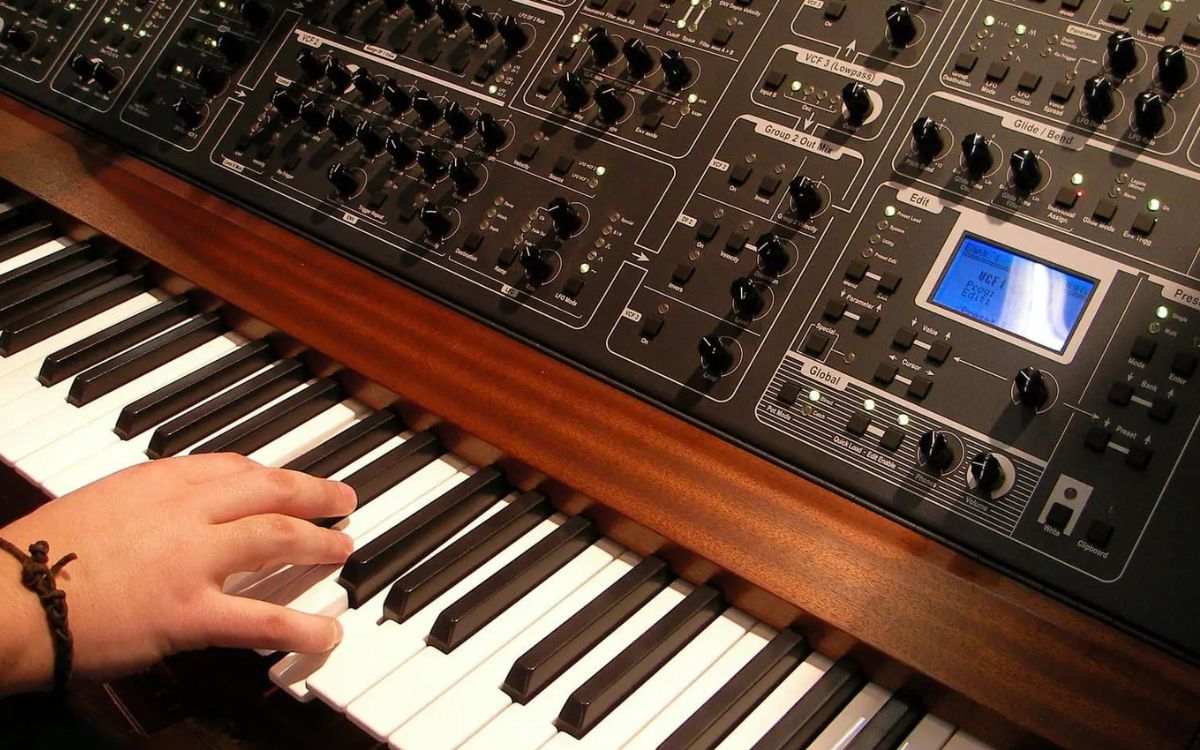Home>Instruments>Synthesizer>What Is A Bus On A Synthesizer?


Synthesizer
What Is A Bus On A Synthesizer?
Modified: January 22, 2024
Discover the importance of a bus on a synthesizer and how it enhances the versatility of this powerful musical instrument. Explore the functions and benefits of the synthesizer bus.
(Many of the links in this article redirect to a specific reviewed product. Your purchase of these products through affiliate links helps to generate commission for AudioLover.com, at no extra cost. Learn more)
Table of Contents
- Introduction
- Definition of a Bus on a Synthesizer
- Types of Buses on a Synthesizer
- Functions and Uses of a Bus on a Synthesizer
- Common Parameters and Controls Found on a Bus
- Examples of Bus Implementations in Synthesizers
- Advantages and Benefits of Using Buses on Synthesizers
- Limitations and Considerations when Using Buses on Synthesizers
- Tips for Using Buses Effectively in Synthesis
- Conclusion
Introduction
Welcome to the exciting world of synthesizers! These remarkable instruments have revolutionized the world of music production and sound design, offering endless possibilities for creating unique and captivating sounds. One of the essential components of a synthesizer that plays a crucial role in shaping and controlling sound is the bus.
Understanding what a bus is and how it functions in a synthesizer is essential for any enthusiast or musician looking to explore the full potential of these instruments. In this article, we will delve into the world of buses on synthesizers, exploring their definition, types, functions, and benefits. So let’s take a deep dive into the fascinating world of synthesizer buses.
A bus, in the context of a synthesizer, refers to a path or channel through which audio or control signals are routed. It serves as a conduit for signal flow, allowing different components within the synthesizer to communicate and interact with each other. Think of it as a virtual cable that connects various modules and elements of the synth, enabling them to work together harmoniously to produce the desired sound.
Buses can be found in both hardware and software synthesizers, serving as a fundamental part of their architecture. They provide a flexible and efficient way to organize and manipulate signals, enabling easy routing, modulation, and processing of audio and control data. With the help of buses, synthesizer users can create complex soundscapes, dynamic textures, and expressive performances.
In the following sections, we will explore different types of buses found on synthesizers, the functions they serve, and the parameters and controls commonly associated with them. We will also delve into real-world examples of bus implementations and discuss the advantages and limitations of using buses in synthesizer designs. Finally, we will provide some valuable tips on how to effectively use buses in your own synthesis adventures.
Definition of a Bus on a Synthesizer
In the world of synthesizers, a bus can be defined as a virtual pathway or channel that allows for the transfer of audio and control signals between different components or modules within the synthesizer. It acts as a central hub that facilitates communication and interaction between these components, enabling them to work together harmoniously to shape and manipulate sound.
Think of a bus as a highway or a pipeline that connects various destinations within the synthesizer. Audio signals, such as oscillators, filters, and amplifiers, as well as control signals, such as modulation sources and envelopes, can be sent along these buses to be processed, mixed, or manipulated.
Buses come in different forms and can serve multiple purposes depending on the synthesizer architecture and design. Some synthesizers may have separate buses for audio and control signals, while others may use a single bus for both types of signals. The number of buses and their configurations can vary, offering different routing options and flexibility.
Through the use of buses, synthesizer users have the ability to create complex sonic landscapes by combining and manipulating various audio and control sources. By routing signals through buses, the synthesizer’s modules can interact, affecting each other in real-time and producing unique and expressive sounds.
It’s important to note that buses are not limited to physical connections or cables but are rather virtual representations of signal paths. They can be implemented at the hardware level, where physical connections are made within the synth’s circuitry, or at the software level, where signals are routed through digital pathways within the synth’s software interface.
Overall, buses play a fundamental role in the architecture and functionality of a synthesizer. They provide the means for different components to communicate and collaborate, allowing for endless possibilities in sound shaping and synthesis exploration.
Types of Buses on a Synthesizer
In the world of synthesizers, there are various types of buses that serve different purposes and functions within a synthesizer’s architecture. Let’s explore some of the most common types:
- Audio Bus: An audio bus is a type of bus that handles the routing and processing of audio signals within a synthesizer. It allows for the connection and manipulation of audio-generating modules, such as oscillators, filters, and amplifiers. Audio buses typically carry the raw waveforms and sound sources that are then shaped and sculpted through further signal processing.
- Control Bus: A control bus is responsible for routing and transmitting control signals within the synthesizer. These signals can include modulation sources like LFOs (Low-Frequency Oscillators), envelopes, and MIDI controllers. Control buses allow for the modulation and manipulation of various parameters and settings in real-time, bringing movement, expressiveness, and dynamic changes to the synthesized sound.
- Mix Bus: A mix bus is used for combining multiple audio signals together. It acts as a central mixing point where the audio signals from different modules, such as oscillators, filters, and effects, are routed and summed. This allows for greater control over the overall volume and balance of the synthesized sound.
- FX Bus: An FX (effects) bus is dedicated to routing audio signals to external effects processors or internal effects modules within the synthesizer. It allows for the application of various effects, such as reverb, delay, chorus, and distortion, to the audio signals before they reach the final output. FX buses offer additional sonic possibilities and can greatly enhance the depth and character of the synthesized sound.
- CV/Gate Bus: CV (Control Voltage) and Gate buses are commonly found on modular synthesizers and are used for transmitting control voltages and gate signals between different modules. CV signals control parameters like pitch, filter cutoff, and modulation depth, while Gate signals control the triggering and gating of envelopes and other events. These buses allow for the interconnection and modulation of various modules in a modular synth system.
It’s worth noting that the specific types and configurations of buses can vary depending on the synthesizer model and design. Some synthesizers may have a limited number of buses, while others may offer more complex routing options with separate buses for different signal types. The choice and implementation of buses in a synthesizer depend on the intended functionality and the sonic possibilities desired by the designer.
Understanding the different types of buses available in a synthesizer is crucial for harnessing the full potential of the instrument. The ability to route and process audio and control signals effectively through these buses opens up endless possibilities in sound creation and manipulation.
Functions and Uses of a Bus on a Synthesizer
Buses play a crucial role in shaping and manipulating sound on a synthesizer. They offer a wide range of functions and uses, enabling users to create complex and expressive sounds. Let’s explore some of the key functions and uses of buses on a synthesizer:
- Signal Routing: One of the primary functions of a bus is to route audio and control signals between different components or modules within the synthesizer. By connecting modules through buses, users can define the signal flow and determine how different elements interact with each other. This allows for the creation of diverse and intricate soundscapes.
- Modulation: Buses are essential for implementing modulation in synthesis. By sending control signals, such as LFOs or envelopes, through a bus to various parameters, users can achieve dynamic and evolving sound textures. Modulation via buses allows for effects like vibrato, tremolo, filter sweeps, and more, adding depth and expression to the sound.
- Mixing and Level Control: Buses provide the means to mix and control the levels of different audio signals within the synthesizer. By routing audio signals to a mix bus, users can adjust the volume, balance, and panning of individual sounds, creating a cohesive and balanced mix. Buses allow for precise control over the overall sonic character of the synthesized sound.
- Processing and Effects: Buses can be used to route audio signals to external effects processors or internal effects modules within the synthesizer. This enables users to apply various effects, such as reverb, delay, modulation, and distortion, to enhance and shape the sound. By sending signals through an FX bus, users can add depth, texture, and character to their synthesized sounds.
- Parameter Control: Buses are instrumental in controlling and modulating various parameters on a synthesizer. By using control signals sent through buses, users can dynamically manipulate parameters like pitch, filter cutoff, modulation depth, and more. Buses facilitate real-time parameter control, allowing for expressive performances and unique sound explorations.
- Integration with External Gear: Buses on a synthesizer can be used to interface and integrate with external gear, such as MIDI controllers, sequencers, or other synthesizers. This enables users to send and receive control signals, trigger events, and synchronize multiple devices, expanding the creative possibilities and potential of the synthesizer setup.
The functions and uses of buses on a synthesizer are diverse and versatile. They offer the means to shape sound, create complex textures, apply effects, and control parameters, allowing users to unleash their creativity and achieve their desired sonic vision. Understanding how to effectively utilize buses is key to unlocking the full potential of a synthesizer and creating captivating and unique musical experiences.
Common Parameters and Controls Found on a Bus
When working with buses on a synthesizer, there are several common parameters and controls that are typically associated with them. These parameters and controls allow for fine-tuning and shaping of the audio and control signals that pass through the bus. Let’s explore some of the most common ones:
- Level/Volume: The level or volume control determines the overall amplitude of the signal passing through the bus. It allows users to adjust the output level and balance the signal with other sounds in the mix.
- Panning: Panning controls the placement of the audio signal within the stereo field. It enables users to position the sound anywhere between the left and right channels, creating a sense of space and width in the mix.
- Send Level: Send level controls the amount of signal being sent from a source module to a particular bus. It enables users to determine the strength of the signal being sent for further processing or mixing.
- Modulation Depth/Amount: This parameter determines the intensity or strength of modulation being applied to a particular parameter or destination. It allows users to control how much the modulation source influences the target parameter.
- Mute/Solo: Mute and solo controls provide the ability to silence or isolate a particular bus or channel. Muting a bus means the signal passing through it will be temporarily silenced, while soloing a bus means only that bus will be audible, muting all other buses or channels.
- Filter Cutoff: Filter cutoff determines the frequency at which the audio signal passing through the bus will be attenuated. It allows for shaping the timbre and tone of the sound and can create dramatic or subtle changes in the frequency content.
- Envelope Amount: Envelope amount controls the influence of an envelope generator on a specific parameter or destination. It determines how much the envelope affects the parameter, such as controlling the filter envelope amount for creating dynamic filter sweeps.
- Delay Time/Feedback: In the case of an FX bus, parameters such as delay time and feedback control the characteristics of the delay effect. Delay time sets the length of the delay, while feedback determines the number of repetitions and the amount of regeneration in the delay signal.
- Effect Wet/Dry Mix: The wet/dry mix controls the balance between the processed (wet) and unprocessed (dry) signals in an effects chain. It allows users to blend the original sound with the processed sound to achieve the desired effect.
These are just a few examples of the parameters and controls commonly found on buses in synthesizers. The specific parameters and controls can vary depending on the synthesizer model and design. Understanding how to manipulate and adjust these parameters is essential for achieving precise control and creative expression within the context of a bus.
Examples of Bus Implementations in Synthesizers
Bus implementations in synthesizers can vary greatly depending on the architecture and design of the instrument. Here are a few examples of common bus implementations found in synthesizers:
- Audio Routing Bus: This type of bus allows users to route audio signals from different sound-generating modules, such as oscillators and filters, to various destinations within the synthesizer. It provides flexibility in creating complex sound combinations and allows for parallel or serial signal processing.
- Modulation Bus: A modulation bus is often found in synthesizers to route control signals, such as LFOs or envelopes, to shape and modulate various parameters. It enables dynamic and expressive sound manipulation by controlling elements like pitch, filter cutoff, and modulation depth.
- Mixer Bus: Synthesizers often feature a mixer bus that allows users to blend and control the levels of multiple audio signals. This bus combines the outputs from different sound sources and modules, giving users greater control over the overall balance and volume of the synthesized sound.
- FX Send/Return Bus: Many synthesizers include an FX bus that allows users to send signals to external effects processors or internal effects modules. By routing signals to the FX bus, users can apply various effects like reverb, delay, and modulation to the audio signals, enhancing their sonic characteristics.
- CV/Gate Bus: Modular synthesizers often make use of CV/Gate buses for controlling and modulating parameters across different modules. These buses transmit control voltages and gate signals, enabling intercommunication between modules and facilitating complex and dynamic sound generation.
These are just a few examples of bus implementations in synthesizers, and different synth models may offer unique or additional types of buses based on their specific architecture. The implementation and functionality of buses can greatly impact the sound creation process and provide users with versatile tools for sonic exploration and expression.
Advantages and Benefits of Using Buses on Synthesizers
The use of buses on synthesizers offers several advantages and benefits that enhance the sound creation process and provide greater control over the synthesized output. Here are some of the key advantages of using buses:
- Efficient Signal Routing: Buses provide a streamlined and efficient way to route audio and control signals within a synthesizer. They simplify the signal flow by eliminating the need for complex and messy patching connections, allowing for easy organization and management of the signal paths.
- Flexibility and Modularity: Buses enable users to create complex and modular sound architectures by interconnecting different components within the synthesizer. This modularity allows for easy experimentation, sound exploration, and the creation of unique and evolving sonic textures.
- Real-Time Modulation: Buses facilitate real-time modulation by allowing users to route control signals to various parameters and destinations. This enables dynamic and expressive sound manipulation, such as creating evolving textures, rhythmic patterns, and expressive performances.
- Efficient Mixing and Level Control: With buses, users can efficiently mix and control the levels of multiple audio signals. By routing signals to a mix bus, they gain precise control over the overall balance, volume, and panning of different sound sources, resulting in a cohesive and well-balanced mix.
- Integration with External Gear: Buses provide the means to interface and integrate with external gear, such as MIDI controllers, sequencers, or other synthesizers. This allows for seamless integration, synchronization, and control between multiple devices, expanding the creative possibilities and potential of the synthesizer setup.
- Flexible Effects Application: By using buses, synthesizer users can easily apply effects to their sound. Whether routing audio signals to external effects processors or internal effects modules, buses offer the flexibility to apply various effects like reverb, delay, modulation, and more, adding depth, character, and dimension to the sound.
The advantages and benefits of using buses on synthesizers are manifold. They increase efficiency in signal routing, enable flexibility in sound design, facilitate real-time modulation, provide precise mixing control, allow integration with external gear, and offer versatile effects application. Ultimately, buses empower synthesizer users to create unique and expressive sounds that captivate and inspire.
Limitations and Considerations when Using Buses on Synthesizers
While buses on synthesizers offer numerous advantages, it is important to be aware of their limitations and consider certain factors when using them. Here are some key limitations and considerations when working with buses:
- Signal Degradation: Each time a signal is routed through a bus, there is a potential for signal degradation or loss of fidelity. This can be due to factors like impedance, noise, or limited bandwidth. It is crucial to consider the quality of the bus implementation and ensure proper gain staging to minimize any potential degradation.
- Complexity and Signal Flow Management: As the number of modules and buses in a synthesizer grows, the complexity of managing signal flow increases. Careful organization and labeling of buses and modules becomes crucial to avoid confusion and maintain a clear understanding of the overall signal path.
- Potential for Signal Interference: When multiple modules share the same bus, there is a possibility of signal interference or unwanted interaction. This can lead to unintended modulation or cross-talk between different sound sources. Understanding the interactions between modules and adjusting parameters accordingly can help alleviate such issues.
- Finite Resources: In some cases, synthesizers may have a limited number of buses or available routing options. It is important to plan and allocate the available resources effectively to meet the desired sound design goals. Prioritizing and selecting the most critical signal routing paths can ensure efficient use of available resources.
- Processor and Memory Constraints: Synthesizers, especially in the digital realm, may have processing and memory limitations. Routing a large number of signals through multiple buses can put a strain on the system, potentially leading to latency or reduced performance. It is vital to be mindful of the synthesizer’s capabilities and limitations when utilizing buses in complex patches.
- Learning Curve: Understanding the intricacies of bus routing, modulation, and signal flow can involve a learning curve. It may take time to master and fully harness the potential of buses in synthesizers. Investing time in studying the synthesizer’s architecture and experimenting with different routing strategies can shorten the learning curve and unlock greater creative possibilities.
By considering these limitations and factors, synthesizer users can make informed decisions when utilizing buses in their sound design and ensure optimal performance and sonic fidelity. Understanding the trade-offs and finding the right balance between complexity and efficiency is key to achieving the desired creative outcomes.
Tips for Using Buses Effectively in Synthesis
When working with buses in synthesis, implementing them effectively can greatly enhance your sound design capabilities. Here are some valuable tips to consider when using buses in your synthesizer workflow:
- Plan Ahead: Before diving into bus routing, have a clear idea of your sound design goals. Plan out the signal flow and determine which modules and parameters will benefit from bus implementation.
- Organize and Label: Properly label and organize your buses and modules to maintain a clear understanding of the signal flow. This will make it easier to manage and troubleshoot your patches, especially as they grow in complexity.
- Experiment with Routing: Don’t be afraid to experiment with different routing options and signal combinations. Routing signals through different buses can yield surprising and unique results. It can also help you understand the sonic interactions between modules and inspire new creative ideas.
- Modulate with Precision: Take advantage of bus modulation to breathe life into your sounds. Pay attention to modulation depth and rates, ensuring that they are finely tuned to achieve the desired sonic effect. Experiment with different modulation sources and destinations to create dynamic and expressive textures.
- Balance and Mix Carefully: When working with audio buses, pay close attention to the balance and mix of your sound sources. Use level controls and panning to create a coherent and balanced stereo image. A well-balanced mix will ensure that each element of your sound is heard clearly and contributes to the overall sonic experience.
- Consider Effects Placement: Experiment with routing audio signals to effects buses to add depth and character to your sounds. Consider the placement of effects in the signal chain, as it can greatly impact the resulting sound. Try different combinations and settings to achieve the desired sonic effect.
- Optimize Performance: Keep in mind the processing power and memory limitations of your synthesizer. In complex patches with multiple buses and modules, optimize your patch for efficiency to avoid latency and maximize the system’s performance.
- Study Synthesizer Documentation: Take the time to thoroughly read the synthesizer’s documentation or user manual to fully understand the capabilities and features of the bus system. Familiarize yourself with any unique implementation details or considerations specific to your synthesizer model.
With these tips in mind, you can effectively harness the power of buses in synthesis and unlock a world of creativity and sonic possibilities. Don’t be afraid to experiment, tweak, and refine your bus routing techniques to achieve the desired results in your sound design ventures.
Conclusion
Synthesizer buses are an essential component in the world of sound synthesis, offering a flexible and efficient way to route and manipulate audio and control signals. By understanding the different types of buses, their functions, and their associated parameters, synthesizer enthusiasts and musicians can unlock a wealth of creative possibilities.
Throughout this article, we explored the definition of a bus on a synthesizer and the various types of buses commonly found in synthesizers, including audio buses, control buses, mix buses, FX buses, and CV/Gate buses. We also discussed the functions and uses of buses, such as signal routing, modulation, mixing, effects application, parameter control, and integration with external gear.
Additionally, we highlighted the advantages of using buses in synthesizers, including efficient signal routing, flexibility, real-time modulation, precise mixing control, and the ability to integrate with external gear. We also considered the limitations and factors to consider when utilizing buses, such as signal degradation, complexity of signal flow management, potential for interference, and finite resources.
To use buses effectively, we provided tips on planning ahead, organizing and labeling, experimenting with routing and modulation, balancing and mixing carefully, considering effects placement, optimizing performance, and studying synthesizer documentation.
In conclusion, synthesizer buses offer a powerful tool for sound designers, musicians, and enthusiasts to shape, modulate, and manipulate sound. By understanding their capabilities and implementing them effectively, users can create captivating and expressive sonic landscapes, pushing the boundaries of their musical creativity.











